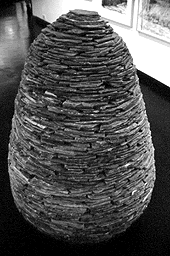| Sheepfolds to Visit | |
News | Education | Images | Accessibility | Search | Links |
 |
The nature of the different stone used by Andy Goldsworthy and the wallers in constructing his cones and folds can lead to an understanding of the GEOGRAPHY and GEOLOGY of Cumbria and link to studies in SCIENCE. 'The Lake District ... contains
a surprising number of different rock types and The southern part of the Lake
District is made up of Silurian slates, which include shales and
flags as well as true slates. These resemble the Skiddaw slates
... which produce slabs for walling. Where the Coniston and Brathay
flags occur at the boundary of the Silurian slates and Borrowdale
volcanics, roughly quarried slates are sometimes used upright
to make stone fences. Many examples can be found around Coniston,
Hawkshead and Ambleside. Dry stone walls, sheepfolds, limestone kilns and field barns are also habitats for a wide range of flora and fauna and present the possibility of studying many species of flowers, grasses, mosses, lichens, animals, birds and insects as part of the SCIENCE curriculum. (6) The Sheepfolds project can give rise to work in MATHEMATICS, looking at pattern and tessellation in wall building. The shape, area, dimensions and proportions of the folds were often based on careful calculations. 'To minimise snow deposit within the stell, the height of a circumference wall in relation to diameter is crucial: thus for stells up to 15 yards [about 15 metres] in diameter this height should be 6 feet [about 2 metres]. Most stells were 8 to 15 yards [approx. 8 to 15 metres] in diameter, depending on the size of their heft'. (7) (A stell is a sheepfold that provides shelter for sheep and a heft is the area of fell land grazed by a particular flock of sheep.) Andy Goldsworthy's cones too are built to careful measurements, where the size of the base, the maximum width and the final height are in ratio 3: 5: 7. He has found that these proportions form the strongest structure to allow the weight of the stone to curve out and then in. The cones completed at Raisbeck, Outhgill, Brough and Bolton are approximately 2 metres high, have about 25 courses and, altogether, contain 3-4 tons of stone in each cone. Each time Andy Goldsworthy builds a fold, Dick Capel, the Sheepfolds Commissions Manager, has an interesting mathematical problem in calculating the amount of stone required to build a fold. If it is approximately two metres high and three metres in diameter he must calculate the circumference to find how many tons will be needed. Approximately one ton of stone is used per metre of wall.
|

|
|
© 2002 Copyright
Information
|
.